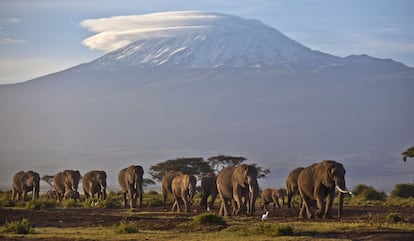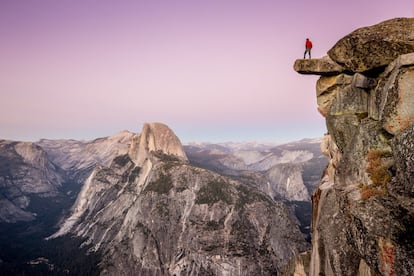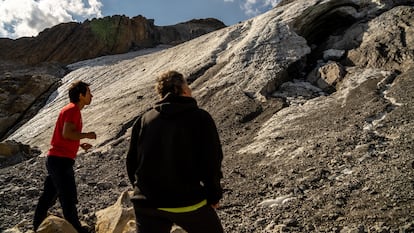Climate change: 460 World Heritage glaciers will be wiped off the map by 2050
UNESCO warns that these ice masses will have disappeared entirely from emblematic places such as the Pyrenees, Kilimanjaro and the Yellowstone and Yosemite National Parks

There are some victims of the climate crisis who are hopelessly condemned to death. After decades of ignoring scientific warnings, the enormous amount of greenhouse gases that humankind has already pumped into the atmosphere has generated a warming that will cause irreversible impacts for hundreds or thousands of years. High on the damage list is the loss of the world’s glaciers, the great masses of ice and snow that accumulate in mountainous areas and polar regions. UNESCO has carried out a study to assess the impact of global warming on the 50 World Heritage Sites that contain glaciers. This UN body concludes that in 17 of these areas, these formations will no longer exist by 2050 regardless of the level of warming that is reached by then or the measures put in place to slow the march of climate change.
In total, there are 460 glaciers that UNESCO forecasts the climate crisis will erase from the map. Among these are the last glaciers in Africa (located in the Kilimanjaro mountains, Kenya and the Ruwenzori-Virunga in central Africa) and many others from emblematic places in Europe and North America including the Dolomites (Italy), the Pyrenees-Mont Perdu (between France and Spain) and the American national parks of Yellowstone and Yosemite.
The UNESCO report bases its predictions on the current level of warming, which most scientists agree stands at around 1.1 degrees Celsius compared to pre-industrial times. However, although the trend in ice and snow volume reduction is extremely negative, what happens to the glaciers located in the other 33 World Heritage Sites analyzed remains, to a certain extent, in the hands of human beings: “They could be saved if greenhouse gas emissions are drastically reduced to limit global warming to 1.5 degrees Celsius,” the report states, citing the most ambitious objective of the Paris Climate Accords. To achieve this, science has made it clear that it is imperative for humanity to move away from the use of fossil fuels – oil, gas and coal – as swiftly as possible.
At the moment, there are “more than 200,000 glaciers in the world, of which about 18,600 are located in World Heritage sites,” Tales Carvalho Resende, the main author of the UNESCO report, tells EL PAÍS. “World Heritage glaciers cover an area of about 66,000 square kilometers, which represents almost 10% of the glaciated area of the Earth’s surface.”
There are currently 1,154 World Heritage Sites and the study focuses on those 50 that contain ice formations of this type, among which are the highest in the world – located on Mount Everest – the longest – in Alaska – and the last remaining glaciers in Africa. Using satellite images, the report analyzes the evolution of these glaciers throughout the 21st century. The bottom line is that all of them “are retreating.”
“All glacierized World Heritage sites had a negative mass balance from 2000 to 2020, meaning that they lost more ice than they gained. Overall, World Heritage glaciers lost around 1,163 billion tonnes of ice during that period, representing on average some 58 billion tonnes of ice per year – an amount equivalent to the total annual volume of water consumed in France and Spain together,“ the report states. “Assuming that all meltwater ultimately reached the ocean, ice loss in World Heritage sites caused around 4.5% of the observed global sea-level rise from 2000 to 2020 – some 3.22 millimetres.” Although a reduction in the size of glaciers located inside World Heritage areas has been detected across all regions, those that have suffered the greatest loss of ice during the 21st century are concentrated in North America, Greenland and Iceland.

The disappearance of these formations not only signifies the destruction of centuries-old or millenary landscapes, but also affects localized hydrology. The report cites, for example, “the expansion of glacial lakes” and changes in the flow of some North American rivers as among the consequences of glacier loss. In other cases, gigantic tsunamis associated with this melting have already been recorded, such as the landslide that occurred in October 2015 in the Wrangell-St. Elias National Park and Preserve in the US, which reached 190 meters in height.
Although all the glaciers in UNESCO-protected sites have retreated due to global warming, “the fastest-accelerating ice loss rates were found in sites with smaller glacierized areas” – those that have a surface area of less than 10 square kilometers and are more sensitive to climate change. These are the glaciers that will be irretrievably lost by mid-century regardless of the level of warming that is reached, according to the UNESCO study.
“The largest glaciers can take hundreds of years to respond to climate changes, while the small ones can require only one or two decades,” Carvalho notes. “The largest glaciers in the world spread and grow under the weight of accumulated snowfall, but the small ones depend more on the snow carried by a storm or an avalanche and, in general, they remain in one place. During hot summers, the smaller glaciers lose mass as meltwater, which feeds streams and irrigation systems in the lower valleys. On average, glaciers grow by 1.5 to 2 meters each winter and shrink by 2.5 to 3 meters each summer. In an especially hot summer, a very small glacier can lose up to 20% of its mass.”

What happens to the largest glaciers will depend on how climate change evolves. Under the most pessimistic scenario, with unchecked emissions and a temperature increase of around 4 degrees Celsius by the end of the century, the glaciers of another 10 World Heritage Sites – which comprise an area of between 10 and 100 square kilometers – “could almost completely disappear by 2100,” the report states. In this case, the loss of ice mass would be equivalent to a sea-level rise of 20 millimeters.
But if emissions are drastically reduced to limit global warming to 1.5 degrees in line with the Paris Climate Accords, ice loss could be reduced and the glaciers of the 33 World Heritage sites analyzed in the report could be saved. “These results emphasize the strong influence the reduction of emissions could have on the magnitude of ice loss and on World Heritage glaciers preservation,” the report states. Along the same lines, Audrey Azoulay, Director General of UNESCO, adds: “This report is a call to action. Only a rapid reduction in current CO₂ emissions can provide hope of saving glaciers and the exceptional biodiversity that depends on them.”
Tu suscripción se está usando en otro dispositivo
¿Quieres añadir otro usuario a tu suscripción?
Si continúas leyendo en este dispositivo, no se podrá leer en el otro.
FlechaTu suscripción se está usando en otro dispositivo y solo puedes acceder a EL PAÍS desde un dispositivo a la vez.
Si quieres compartir tu cuenta, cambia tu suscripción a la modalidad Premium, así podrás añadir otro usuario. Cada uno accederá con su propia cuenta de email, lo que os permitirá personalizar vuestra experiencia en EL PAÍS.
¿Tienes una suscripción de empresa? Accede aquí para contratar más cuentas.
En el caso de no saber quién está usando tu cuenta, te recomendamos cambiar tu contraseña aquí.
Si decides continuar compartiendo tu cuenta, este mensaje se mostrará en tu dispositivo y en el de la otra persona que está usando tu cuenta de forma indefinida, afectando a tu experiencia de lectura. Puedes consultar aquí los términos y condiciones de la suscripción digital.
More information
Archived In
Últimas noticias
Most viewed
- Oona Chaplin: ‘I told James Cameron that I was living in a treehouse and starting a permaculture project with a friend’
- Reinhard Genzel, Nobel laureate in physics: ‘One-minute videos will never give you the truth’
- Sinaloa Cartel war is taking its toll on Los Chapitos
- Why the price of coffee has skyrocketed: from Brazilian plantations to specialty coffee houses
- Silver prices are going crazy: This is what’s fueling the rally











































